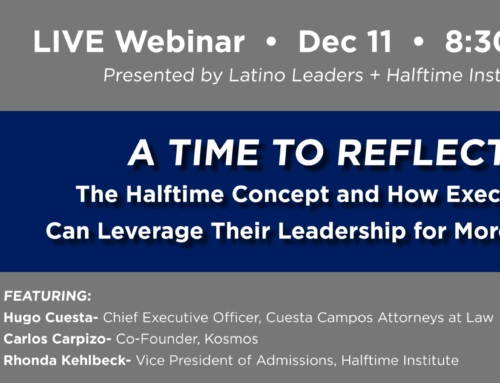Navigating this mid-life adventure called halftime is a journey like no other. Doing it alone is a trap that many fall into, hindering their potential for balance, impact and joy in their second half of life. Creating a Personal Board of Directors is an effective way to avoid the common pitfalls and roadblocks that I’ve seen derail people along the way.
In my previous article, 4 Reasons You Need a Personal Board of Directors, I outline how a Personal Board of Directors can be helpful and provide long-term benefits to the significance of your journey. It can, and most likely will, be hard work to put together a Personal Board, but it is worthwhile in the long run. Get familiar with the benefits so that you can begin with the end in mind.
In this article, I’d like to get a bit more practical: How do you do it?
We all have this image in our head when we say “board of directors” – strict governance, strained relationships, bylaws and motions. Forget about that for a moment. I would encourage you to simply think of a personal board as a group of individuals who care about you enough to come alongside you during a critical time in order to help you make the most informed, obedient decisions for your next season of life.
With that said, here’s how I suggest you approach this:
Jot down a list of 5-7 individuals who you deeply respect and who truly care about you.
Who in your network of friends do you think is wise and thoughtful? Who do you know who has a similar worldview as you and is not afraid to tell you the truth even when it may not be too pleasant? Who truly wants the best for you? Who might present a different viewpoint? Is there anyone who has traversed these waters before? The people who come to mind when you ask these questions are the ones you need to consider.
Think through how you want to communicate to your personal board.
I decided that I would not convene my board in a regular meeting as a group. First of all, my board members were not all local. Second, I saw more value in the opinions of the individuals on my board than I did in the group’s opinion as a whole. So I decided to meet individually with them, either face-to-face or via Skype at least once a month. I also committed to updating the entire board monthly via email to ensure everyone stays on the same page. Other halftimers have chosen to do the opposite: they convene their board (or a portion of their board) together in-person at specific intervals. Decide what makes the most sense for you and for the folks on your list. Remember to be practical with not only their time, but also yours. Unrealistic goals and expectations for “meetings” could discourage you and your Board from the purpose.
Provide your board with a foundation to support and challenge you.
One of my clients wrote a letter via email to his Board sharing three main things: a summary of halftime and what this season of life entails, his personal journey up to this point and his expectations of them as his Personal Board Members. (He has given me permission to share this letter here: Download the Halftime Institute – Personal Board Intro Letter) This type of initial communication grounds your Board in your journey and makes sure everyone understands their role in it. In addition, it opens the door for thoughtful communication and insight because you have demonstrated that this is a valuable, well-considered journey.
Be proactive with your Board and keep the communication frequent and honest.
Whatever frequency of communication you’ve committed to, make sure you do it. Don’t let life get in the way of sharing regularly with your committed few. And, by all means, be honest. If you have selected the right folks, they can handle your varying emotions, your confusion and your frustration without abandoning you. Cry with them and celebrate with them. Vent to them and listen to them. Let them into your world no matter how crazy your world may seem. You have people in your corner, so leverage them by being honest, consistent, and committed.
Let these principles guide your thoughts as you put together your board but don’t overthink it. Simply find a group of people willing to help you and provide enough structure to make it work for them and for you.
I’d love to hear from you. Have you already created a personal board of directors? How is it going? What have you learned? Reply in the comments box of this blog, and let’s keep the conversation going.






